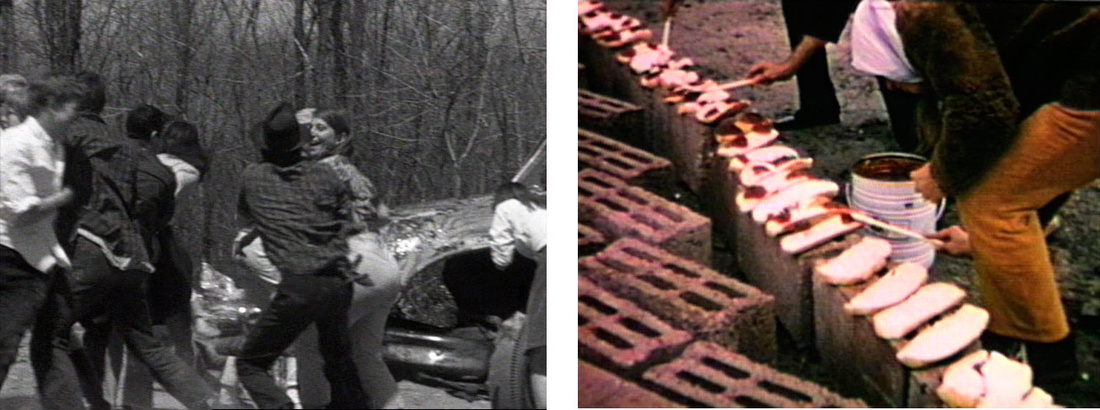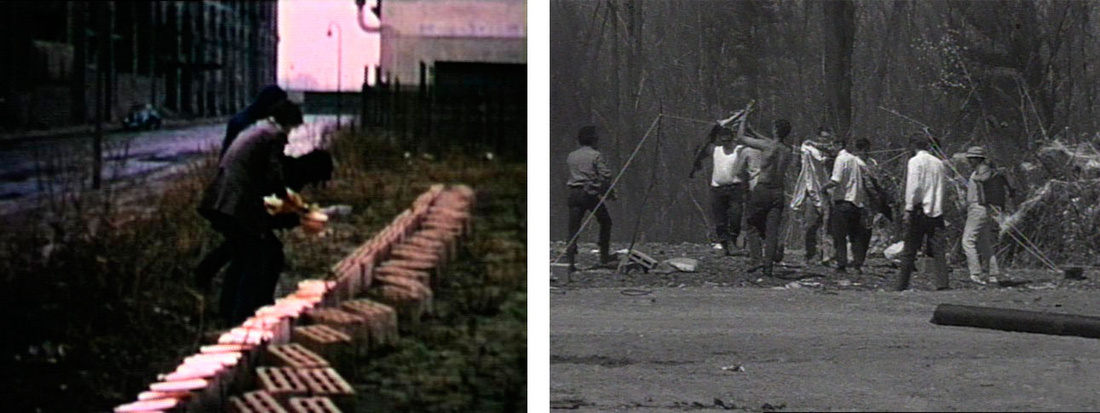A Brief History of “Happenings” in 1960s New York

Left: Allan Kaprow, Household (film still), 1964. Documentation of a Happening commissioned by Cornell University, Ithaca NY; Right: Allan Kaprow, Sweet Wall (film still), 1970. Documentation of a Happening, Galerie René Block, West Berlin. © Allan Kaprow Estate, courtesy of the Estate and Hauser & Wirth.
A man dressed all in red feverishly paints the words “I LOVE WHAT I’M DOING, HELP” on a large canvas, pours two jars of paint over his head, then proceeds to dive headfirst through his finished work. A woman, cradled in the arms of her dance partner, takes a bite from a loaf of challah while reading the Sunday comics. A man wearing a nine-foot-tall costume of a foot performs a routine on the floor of a school gym with another man dressed as a human torso.
These are scenes that unfolded before audiences in a handful of New York galleries and spaces at the start of the 1960's. “Happenings,” as the performances were known, combined elements of dance, theater, music, poetry, and visual art to blur the boundaries between life and art and forge a path for new methods of artistic practice. But for all their historical significance, this genre of work remains elusive and ephemeral—art historian Kirk Varnedoe once said that attempting to preserve the Happenings would be “like trying to catch wind in a butterfly net.”
What were the Happenings?
In October 1959, artist and Rutgers professor Allan Kaprow presented 18 Happenings in 6 Parts at the Reuben Gallery in New York’s East Village. Although he had experimented with the form earlier, this marked the first use of the term “Happening.” (The invitation studiously avoided labels, however, stating: “The present event is created in a medium which Mr. Kaprow finds refreshing to leave untitled.”)

Left: Allan Kaprow, Sweet Wall (film still), 1970. Documentation of a Happening, Galerie René Block, West Berlin; Right: Allan Kaprow, Household (film still), 1964. Documentation of a Happening commissioned by Cornell University, Ithaca NY. © Allan Kaprow Estate, courtesy of the Estate and Hauser & Wirth.
For the 90-minute 18 Happenings, Kaprow constructed three rooms within the gallery from plastic sheeting and wooden beams, each meant to house six separate but simultaneous actions—such as a woman seated and squeezing oranges, two performers proclaiming a nonsensical series of single-syllable words, and painters emblazoning lines and squares on either side of a hanging canvas. Kaprow orchestrated the events with the help of a meticulously planned script of stage directions and scores. Invitations had been sent out informing spectators that “you will become part of the happenings; you will simultaneously experience them.” Each audience member was given instructions upon entering the gallery, specifying when to move seats or applaud.
Although the following four years would see Happenings organized by a range of artists, each with their own distinctive style, all could be characterized by a rough-around-the-edges aesthetic. “Everything about the production was as crude and as primitive as it could be, because nobody really had any money to spend on any of this stuff,” the artist Robert Whitman told the New York Times in retrospect. And while Happenings often had a structure, there was no character development or plot: “It was generally more visual than traditional theater: the accent was on the plastic composition more than storytelling.”
Where did they come from?
The New York Happenings drew inspiration from a variety of sources. In Europe, there were already numerous examples of visual artists experimenting with performance. In early 20th-century Italy, the Futurists had in some instances replaced actors with machinery and moving lights in their performances. In 1920 s and ’30 s Germany, Oskar Schlemmer organized theatrical events at the Bauhaus, combining the skills of resident designers, dancers, and artists. In mid-century France, Yves Klein dragged nude models covered in paint across canvases as spectators looked on.
In the United States, experimental composer and musician John Cage was particularly influential in the development of the Happenings. In 1952, he organized an event at Black Mountain College—a 45-minute performance in which participants engaged in actions of their choosing—that would be seen as a precursor to Kaprow’s later explorations. Robert Rauschenberg, for example, hung his “White Paintings” from the rafters and projected slides onto them, while choreographer Merce Cunningham danced throughout the room.
But it was Kaprow’s musings on the legacy of Jackson Pollock that most clearly laid the foundations for the movement. In a 1958 essay for ARTnews, he wrote, “Pollock, as I see him, left us at the point where we must become preoccupied with and even dazzled by the space and objects of our everyday life.” The action implicit in the Abstract Expressionist’s legendary drip paintings would become explicit with the Happenings, which were also influenced by the concept of assembling found objects that originated with the Dadaists and continued with Rauschenberg’s Combines.
Who were the major players?
Kaprow, an academic and artist, was widely considered the leader of the group. His Happenings were often the most boundary-pushing, placing viewers in positions of extreme unease, even fear—during “A Spring Happening,” members of the audience stood in narrow tunnels, exposed to rapidly flashing lights and eardrum-rattling sounds. The Happening concluded with a blank-faced performer walking towards the audience pushing an electric lawnmower, forcing them back towards the lobby. During most performances, one or two people would flee the room, overwhelmed.
Although the term “Happening” hints at a spontaneous event, they were determined by whichever artist was in charge. Kaprow’s were carefully planned and deeply intellectual. Red Grooms, on the other hand, often came up with the particulars for his Happenings—which were noisy, physical, and carnival-esque—on the fly. The Burning Building, which followed 18 Happenings in December 1959, featured a cast of characters including the Pasty Man (Grooms himself, wearing white face paint), the Girl in a White Box, and two Firemen. It was a great success with the audience; although Grooms planned for one performance per night, by popular demand it was performed four times on opening night. Its success led to the first group show for Happenings, “An Evening of Happenings,” in January 1960, organized by Kaprow. Whitman, whose Happenings tended towards the poetic, was included for the first time in this show with his work American Moon.
The following month, Jim Dine and Claes Oldenburg performed in the group show “Ray Gun Spex,” a series of seven performances within built environments they had constructed at New York’s Judson Gallery (the renovated basement of a church). Simone Forti, dancer and artist, was the only woman who devised a Happening of her own in the Reuben Gallery—two, in fact, entitled See Saw and Rollers. Carolee Schneemann was the other major female artist involved in planning the Happenings, joining the group in 1960 as a participant in one of Oldenburg’s events. Feminist artists would become leading pioneers of performance art in the late ’60s and ’70s.
Why did they matter?
The Happenings burned bright and fast, tapering off in 1963 when Kaprow moved on. Grooms and Oldenburg had already left to pursue other projects. News of the novel art form had started to travel—there were “thrill clubs” that came from Long Island to experience the Happenings and, for Oldenburg, the “audience became less and less interesting to me. I couldn’t really reach them.” The term “Happening” became such an accepted part of 1960s vernacular that it was used as a title for a song by girl group The Supremes.
Despite the brevity of the movement and the difficulty of reconstructing the original events, the Happenings were formative for the artists involved. Oldenburg’s built environments, used as backdrops for several of his events, for example, marked the beginning of his experimentation with soft sculptures that would become his signature form of art, commenting on American culture and consumerism.

Marta Minujín, Momentos de la performance Leyendo las noticias, 1965, Costanera Sur, Buenos Aires. Images via Wikimedia Commons.
The Happenings upended the conventions of what art could be, going beyond sculpture and painting to introduce a blending of mediums that would later become performance art and body art. Kaprow wrote in a 1966 essay that “the line between the Happening and daily life should be kept as fluid and perhaps indistinct as possible”—a revolution in the conception of artmaking, enticing artists to consider and reimagine audiences as part of their work. Although they remain an ephemeral moment in art history, the Happenings made a lasting impact on generations of artists.
—Abigail Cain
No comments:
Post a Comment